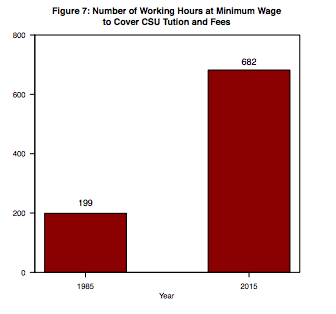The California Faculty Association released a report to faculty members revealing that the rising number of minority, low-income and first-generation students receive less funding throughout the 23 CSUs than what the predominantly white student population in the 80s received.
According to the report’s Executive Summary, “California is spending less for each student today, when nearly 3-in-4 are students of color, than it did in 1985 when the majority of CSU students were white.”
CFA president and Cal State East Bay philosophy and public affairs professor, Jennifer Eagan, says that many people see this issue as a new problem if they acknowledge the problem at all. However, as the report discusses, the funding has been in consistent decline for the past 30 years.
According to CFA President and professor Jennifer Eagan, the problem, is that this new demographic of students have unique challenges that require more funding than what is available.
“It is heart wrenching for me that students in classrooms need far more money for support. I invite politicians into my office to see students that I deal with, to see that students come in with much more profound problems, like first-generation students coming into my office hours with housing and hunger issue questions,” San Francisco State University CFA Chapter President Sheila Tully said. “But none have taken up the invitation.”
As noted in the report, “California spends 41 percent less on CSU students today than when we did in 1985.”

“As the student body of the CSU became darker, funding became lighter,” said a CSU faculty member who testified at a State Assembly hearing on the issue in October of 2016.
Tully said politicians need to see the “cause and effect” of this issue to truly understand this problem and work to solve it. According to Eagan, the aim of the report is to facilitate that understanding.
“Our goal is to lay out information very clearly for legislators to see this problem, and laying out in numbers and statistics to tell the whole story in terms of data,” Eagan said.
When asked if faculty members were aware of or surprised by the findings of the report, Eagan said, “Faculty members have seen the stories in experience.”
According to Tully, it still “isn’t clear” as to why this change in student make up is leading to less CSU funding in the first place. However, the report does make it clear that the decrease in funding and smaller investments in the system are the cause of the now growing student food and housing inequality problem.
The body of the report also includes several student testimonies from CSU Fullerton, CSU San Marcos, CSU Dominguez Hills and Sonoma State University.
“I have had students email me at 10 p.m. saying, ‘I’m spending my first night at the homeless shelter,’ so how do you expect them to come to class on Monday with their assignment?” Tully said. “And it is absurd to have the chancellor say that students should be graduating in four years.”
According to Tully, a lot of students take longer to graduate because they have to work multiple jobs to get through school, or our first-generation students don’t have the financial means because they have families to support.
As Tully points out, CSUs and faculty could do more to provide for students going through these difficult experiences if they had more financial support Eagan added that as the number of students grows, the funding needs to be increased, not decreased. Looking forward, Eagan and the CFA are working to make that happen.
“We plan to lobby together with CSUs to get more money,” Eagan said, but she acknowledges the need for a longer-term plan to solve the CSU funding issues.
Tully said instead of having politicians come down to her office to see the problem first hand, sometimes students themselves go to Sacramento to tell their story and lobby for more financial support.
“Funding education is also very important moving forward with Trump and the new appointee for secretary of education, who has never even stepped foot in a public school,” Tully said.
Natalie Taylor-Ketcham, a 28-year-old physical therapy student working to get her doctorate, has seen this steady decrease in funding with her family and believes funding for public education is critical.
“My brother got a master’s degree at Sacramento State University debt free, but 15 years later my sister, who is working in the same program to get her baccalaureate degree, is in a lot of debt,” Ketcham said.
“We need more funding because a lot of people are suffering from this student debt and for me personally, funding for public education is the number-two priority right after health care, because education opens doors for people. Nobody should feel that they can’t go to school because of money.”
According to the calstate.edu “system-wide information” page, the average amount of student loan debt across CSUs for 2013-2014 school year was about $15,898, whereas the national average was $25,902 for a public four-year university.
The report was compiled and written by several different faculty members across the 23 CSU campuses last summer. According to Eagan, more reports, including research on the effects of financial aid, are due to be released later this year.





